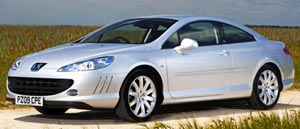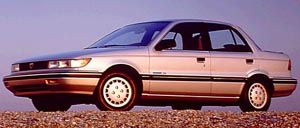Autocade is an international car cyclopædia that’s geographically unbiased, carefully edited for enthusiasts and media who want a quick, accurate reference. There is a greater emphasis on models produced after 1970.
Inside Autocade

Peugeot 407 Coupé (D25). 2005–11 (prod. 860,956 for all 407). 2-door coupé. F/F, 1997 cm³ diesel, 2230 cm³ petrol (I4 DOHC), 2721 cm³ diesel, 2946 cm³ petrol (V6 DOHC). Following from long line of Peugeot coupés though not styled by Pininfarina, but by the company’s in-house team. Slightly more graceful than berline, and greatly changed though its front resembles the regular models’. Nice ride, acceptable handling, but not the fastest and tricky at the limit.
Manufacturing location: Rennes, Bretagne, France
Marque: Peugeot | Model: Peugeot 407 | Predecessor: Peugeot 406 Coupé
q.v. Peugeot 407 (D23)

Mitsubishi Lancer/Eagle Summit (CA/CB). 1988–95 (prod. n/a). 4- and 5-door sedan. F/F, F/A, 1299, 1468, 1755 cm³ petrol, 1796 cm³ diesel (I4 OHC), 1595, 1796 cm³ (I4 DOHC). More rounded Lancer, apeing the style of the larger Galant. Attractive, compact design, balancing the aerodynamic era with sportiness and formality. Four-door sedan replaced in 1991, though liftback, not dissimilar in style to Toyota Celica (T160), continued into the next generation. Wagons from previous generation sold alongside this series. Built in the US as Eagle Summit. Good ride, and decent power from DOHC units.
Manufacturing locations: Kurashiki, Okayama, Japan; Normal, Illinois, USA
Marque: Mitsubishi | Model: Mitsubishi Lancer | Predecessors: Mitsubishi Lancer EX, Mitsubishi Lancer Fiore (1983–7), Renault Alliance, Renault GTA | Successor: Mitsubishi Lancer (1991–5)
BMW was founded originally as Rapp Motor by Karl Friedrich Rapp. Under contract to Austro-Daimler, the company began making V12 engines, and Rapp Motor became Bayerische Motoren Werke GmbH in 1917. Complications led to a takeover by Franz Josef Popp and the company was renamed BMW AG in 1918.
In 1920, the company diversified into motorcycle engines, due to a prohibition on aircraft manufacture under the Treaty of Versailles, before making its own motorcycles from 1921. In 1928, BMW bought Automobilwerk Eisenach, which was manufacturing a Dixi model under licence from Austin (it was a version of the 7), related to the US Bantam and the Japanese Datsun. It was briefly renamed the BMW Dixi.
By 1933, BMW began manufacturing its own models, with the 3/20 PS, with the 303, 327 and 328 models following during the decade. World War II interrupted BMW’s growth, and war production took over.
With its München factory largely destroyed and with restrictions imposed by the Allies, car production did not resume till 1952. In the meantime, Eisenach had been taken over by the Soviets and offered BMWs for sale till 1951. In 1952, BMW successfully prevented its trade marks from being used by Eisenach when the company was transferred by the Soviets to the East German government. (The last BMWs made there were branded EMW.) Reparations saw the 326, 327 and 328 models go to Bristol in the UK.
BMW’s 1950s’ record is less distinguished. While it created exotic models such as the 507, arguably one of its most famous vehicles, they were low-volume, and it produced the Isetta bubble car under licence.
In 1959, financier Herbert Quandt became a shareholder, later the majority shareholder. BMW had almost been sold to Daimler-Benz AG, but opposition from the workforce and trade unions, and advice from the chairman, Kurt Golda, prevented this. Quandt prompted the reorganization of the firm.
The 700, launched the same year, featured a Michelotti-designed body and the 697 cm³ engine from the R67 motorcycle. It was a hit, and BMW continued with the 1500 in 1961, developed by Hofmeister, Fiedler, Wolff and von Falkenhausen. This car set the template for modern BMWs as a sporting saloon, with the 1600, 1800 and 02 series following. A three-tiered saloon range fell into place by 1972 with the launch of the 5er-Reihe, and these three model lines have formed the basis of BMW’s marketing since.
The company wished to be a volume player, and took over Britain’s Rover Group (the successor to Austin, which had given BMW its start in automotive manufacture) in 1993. The takeover proved ill-fated, and BMW sold Rover in 1999, keeping the Mini brand as well as competing trade marks such as Triumph. Rover went to a consortium, and Land Rover went to Ford. There was also an upmarket expansion as BMW bought the rights to the Rolls-Royce name for automotive manufacture in 1998, producing its first Phantom model in 2003.
|
New on Autocade
Here are the 20 latest pages on Autocade.
View all models
Also inside
Of the 4,500-plus pages on Autocade, here is a selection. Or try the ‘Random page’ link to see what cars you recognize—or don’t recognize!
View all models
|




